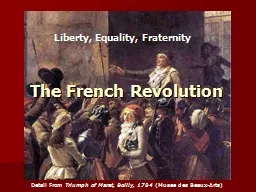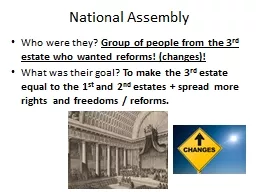PPT-National assembly How did the relationship between the French people and the king change
Author : kittie-lecroy | Published Date : 2018-09-30
Powers of the king Describe the relationship between the French people and king Louis XVI before the French Revolution What rights and powers did the king have What
Presentation Embed Code
Download Presentation
Download Presentation The PPT/PDF document "National assembly How did the relationsh..." is the property of its rightful owner. Permission is granted to download and print the materials on this website for personal, non-commercial use only, and to display it on your personal computer provided you do not modify the materials and that you retain all copyright notices contained in the materials. By downloading content from our website, you accept the terms of this agreement.
National assembly How did the relationship between the French people and the king change: Transcript
Download Rules Of Document
"National assembly How did the relationship between the French people and the king change"The content belongs to its owner. You may download and print it for personal use, without modification, and keep all copyright notices. By downloading, you agree to these terms.
Related Documents














